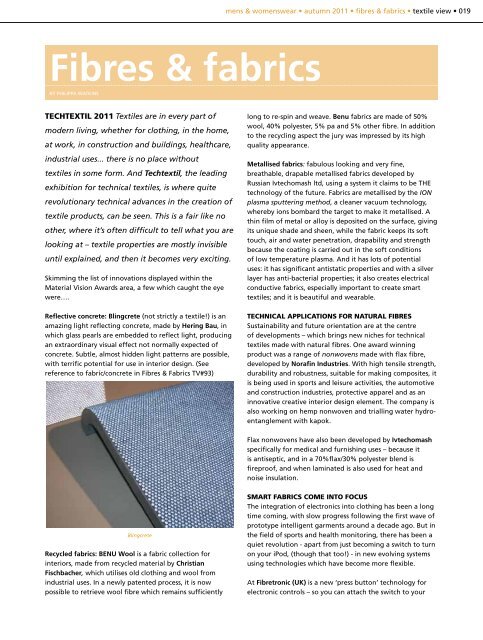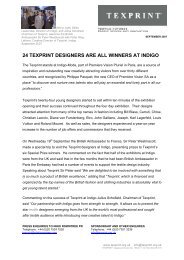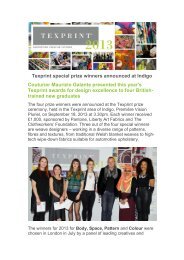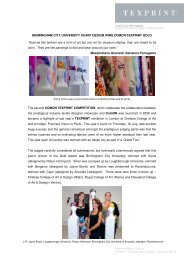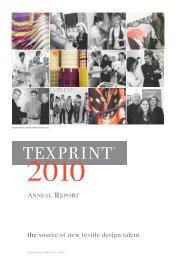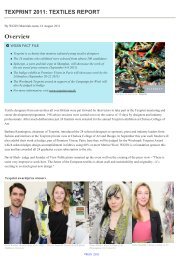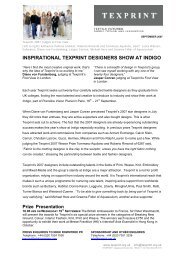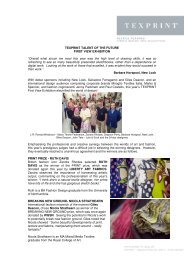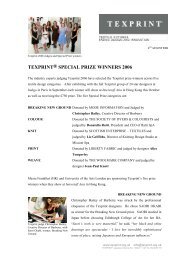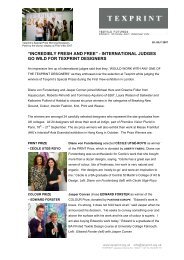Create successful ePaper yourself
Turn your PDF publications into a flip-book with our unique Google optimized e-Paper software.
mens & womenswear • autumn 2011 • fibres & <strong>fabrics</strong> • textile view • 019<br />
<strong>Fibres</strong> & <strong>fabrics</strong><br />
BY PHILIPPA WATKINS<br />
TECHTEXTIL 2011 Textiles are in every part of<br />
modern living, whether for clothing, in the home,<br />
at work, in construction and buildings, healthcare,<br />
industrial uses... there is no place without<br />
textiles in some form. And Techtextil, the leading<br />
exhibition for technical textiles, is where quite<br />
revolutionary technical advances in the creation of<br />
textile products, can be seen. This is a fair like no<br />
other, where it’s often difficult to tell what you are<br />
looking at – textile properties are mostly invisible<br />
until explained, and then it becomes very exciting.<br />
Skimming the list of innovations displayed within the<br />
Material Vision Awards area, a few which caught the eye<br />
were….<br />
Reflective concrete: Blingcrete (not strictly a textile!) is an<br />
amazing light reflecting concrete, made by Hering Bau, in<br />
which glass pearls are embedded to reflect light, producing<br />
an extraordinary visual effect not normally expected of<br />
concrete. Subtle, almost hidden light patterns are possible,<br />
with terrific potential for use in interior design. (See<br />
reference to fabric/concrete in <strong>Fibres</strong> & Fabrics TV#93)<br />
long to re-spin and weave. Benu <strong>fabrics</strong> are made of 50%<br />
wool, 40% polyester, 5% pa and 5% other fibre. In addition<br />
to the recycling aspect the jury was impressed by its high<br />
quality appearance.<br />
Metallised <strong>fabrics</strong>: fabulous looking and very fine,<br />
breathable, drapable metallised <strong>fabrics</strong> developed by<br />
Russian Ivtechomash ltd, using a system it claims to be THE<br />
technology of the future. Fabrics are metallised by the ION<br />
plasma sputtering method, a cleaner vacuum technology,<br />
whereby ions bombard the target to make it metallised. A<br />
thin film of metal or alloy is deposited on the surface, giving<br />
its unique shade and sheen, while the fabric keeps its soft<br />
touch, air and water penetration, drapability and strength<br />
because the coating is carried out in the soft conditions<br />
of low temperature plasma. And it has lots of potential<br />
uses: it has significant antistatic properties and with a silver<br />
layer has anti-bacterial properties; it also creates electrical<br />
conductive <strong>fabrics</strong>, especially important to create smart<br />
textiles; and it is beautiful and wearable.<br />
TECHNICAL APPLICATIONS FOR NATURAL FIBRES<br />
Sustainability and future orientation are at the centre<br />
of developments – which brings new niches for technical<br />
textiles made with natural fibres. One award winning<br />
product was a range of nonwovens made with flax fibre,<br />
developed by Norafin Industries. With high tensile strength,<br />
durability and robustness, suitable for making composites, it<br />
is being used in sports and leisure activities, the automotive<br />
and construction industries, protective apparel and as an<br />
innovative creative interior design element. The company is<br />
also working on hemp nonwoven and trialling water hydroentanglement<br />
with kapok.<br />
Flax nonwovens have also been developed by Ivtechomash<br />
specifically for medical and furnishing uses – because it<br />
is antiseptic, and in a 70%flax/30% polyester blend is<br />
fireproof, and when laminated is also used for heat and<br />
noise insulation.<br />
Blingcrete<br />
Recycled <strong>fabrics</strong>: BENU Wool is a fabric collection for<br />
interiors, made from recycled material by Christian<br />
Fischbacher, which utilises old clothing and wool from<br />
industrial uses. In a newly patented process, it is now<br />
possible to retrieve wool fibre which remains sufficiently<br />
SMART FABRICS COME INTO FOCUS<br />
The integration of electronics into clothing has been a long<br />
time coming, with slow progress following the first wave of<br />
prototype intelligent garments around a decade ago. But in<br />
the field of sports and health monitoring, there has been a<br />
quiet revolution - apart from just becoming a switch to turn<br />
on your iPod, (though that too!) - in new evolving systems<br />
using technologies which have become more flexible.<br />
At Fibretronic (UK) is a new ‘press button’ technology for<br />
electronic controls – so you can attach the switch to your
020 • textile view<br />
mens & womenswear • autumn 2011 • fibres & <strong>fabrics</strong> • textile view • 021<br />
jacket when you<br />
need it. This could<br />
be used to operate<br />
‘i-Lume’, a range of<br />
wearable lighting<br />
systems using high<br />
brightness LED (light<br />
emitting diodes)<br />
technology, which<br />
can be applied to<br />
sportswear, safety<br />
and protective<br />
clothing, backpacks,<br />
gloves, shoes etc.<br />
Or to HEATwear,<br />
a textile heating<br />
system for apparel,<br />
delivering warmth at<br />
the press of a switch<br />
– gloves, jackets, etc.<br />
Top: Intractive Wear iLightX jacket. Bottom: Interactive Wear press stud<br />
Also using LED technologies Interactive Wear (Germany),<br />
has developed ‘iLightX’ a modular system with a robust LED<br />
wiring system, which can be attached and press studded<br />
into garments, in button holes – with a whole range of<br />
uses. Features include bluetooth for iPod etc., solar power<br />
to recharge iPod, and safety visibility for running wear,<br />
workwear and protective garments, leather motorcycle<br />
apparel with micro LEDs. Also applications for interiors<br />
- LEDs have been incorporated into textile floor coverings –<br />
and you could even have a light in your handbag!<br />
And indeed there was much more on show, with an ever<br />
expanding range of possible applications in the areas of<br />
clothing home textiles, furniture and fashion accessories.<br />
ENHANCED SPORTS PERFORMANCE<br />
Biomimicry research has provided many innovative ideas for<br />
performance <strong>fabrics</strong> for sportswear. One such is X-BIONIC<br />
running gear, which is based on the performance of the<br />
fur of the Fennec desert fox, found in the Sahara. The<br />
Fennec emits excessive body heat through its ears, which<br />
in comparison with the rest of its body are enormous. Just<br />
X-BIONIC running outfit<br />
like the fox’s<br />
glossy silvery<br />
fur, the special<br />
knitted texture<br />
of X-BIONIC<br />
functions in a<br />
similar way - it<br />
distributes sweat<br />
across the entire<br />
skin, which when<br />
it evaporates<br />
provides fullsurface<br />
cooling<br />
and a sensation<br />
of running in the<br />
shade - perfectly<br />
attuned to an<br />
athlete’s needs.<br />
ENHANCED PROTECTION<br />
Protection is a big sector for workwear and uniforms. On<br />
show was a wide range of special <strong>fabrics</strong> and technologies,<br />
which allow the wearer to feel good, look professional and<br />
benefit from a high level of functionality and protection.<br />
Swiss Schoeller, the doyenne of performance in functional<br />
<strong>fabrics</strong> with innovative branded technologies, focussed<br />
on <strong>fabrics</strong> for workwear and uniforms. As requirements<br />
increase, heavy duty workwear is being given modern<br />
sun protection – so Schoeller has developed coldblack<br />
for workwear, a new sun protection version for vat dyed<br />
<strong>fabrics</strong>, which makes it suitable for industrial laundering.<br />
Another new product from Schoeller is iLoad (which stands<br />
for intelligent loading, release, washing, reloading), a<br />
reloadable textile for health and wellness. Via an effective<br />
carrier material, active agents can be stored in microencapsulated<br />
emulsions, which could be individually tailored<br />
and delivered to the wearer. Examples could include<br />
addressing sleep disorders, skin complaints and colds.<br />
Cosmetics, wellness, anti-aging and workwear are growth<br />
markets for which iLoad could be appropriately used.<br />
W L Gore launched a new 2-way stretchable Gore-Tex<br />
laminate. Designed for protective clothing in the workplace,<br />
the fabric keeps its essential wind and water proofness,<br />
and breathability, with comfort for the wearer. There is big<br />
interest in comfortable weather and protective clothing,<br />
and W L Gore has created specific garments for different<br />
activities such as Gore bikewear and Gore runningwear.<br />
Also new from W L Gore were heat and flame proof, high<br />
visibility garments with Gore antistatic technology for<br />
weather protection against thermal effects from an electric<br />
event.<br />
FIBRE DEVELOPMENTS<br />
Outlast polyester fibre: known for its pcms (phase change<br />
materials) embedded for temperature regulation, Outlast<br />
has produced a temperature balancing polyester fibre –<br />
awarded a technical innovation prize. A component fibre<br />
with a pcm core inside a polyester sheath, the fibre offers<br />
temperature balancing coupled with the characteristics of<br />
a conventional polyester, resulting in increased comfort<br />
- chilling and sweating are reduced due to the optimum<br />
climate regulation, suitable for products worn next to the<br />
skin, such as socks, T-shirts etc.<br />
Temperature regulation from sea algae: Lenzing has<br />
worked with different product to develop lyocel fibre<br />
variations with different functions. One such is Smartcel<br />
Sensitive and Smartcell Clima, which have pcms (phase<br />
change materials) integrated into lyocel fibres, offering<br />
comfort through climate regulation for sports and athletics<br />
– water sports, hiking, winter sports etc. The advantage<br />
of Smartcell pcms are that they are made from oil derived<br />
from seaplant seeds contained in sea algae from Iceland,<br />
(and not oil based paraffin, like Outlast).<br />
Tencel for automotive: Lenzing’s lyocel fibre, Tencel<br />
is proving to have a number of advantages for the<br />
automotive sector – particularly for its sustainability and<br />
moisture management properties. Thick fibres are used<br />
in carpets, powder forms are used in plastics (injection<br />
molding compound), and textile fibres are used in seat<br />
covers. It is also being produced in a FR version – a flame<br />
resistant agent is permanently integrated in the fibre,<br />
offering protection from heat in a variety of fields of<br />
application.<br />
Miroglio’s new life: Filature Miroglio launched its new<br />
high performance recycled polyester, photo-degradationresistant<br />
filament yarn, Newlife – with permanent UV<br />
resistant performance – a new development also launched<br />
last season for apparel (see <strong>Fibres</strong> & Fabrics TV#94).<br />
Made from post consumption plastic bottles collected<br />
in northern Italy, significant elements of the process are<br />
its traceability throughout the supply chain, while the<br />
end product is derived using a mechanical and NOT<br />
a chemical process. With less energy used during<br />
processing, Newlife yarns can be supplied stock dyed<br />
to maximise it eco-profile by using less water, and can<br />
be treated to resist bacteria. Home furnishing specialist<br />
Bekaert Textiles has already used the fibre in a new line<br />
of mattress tickings.<br />
THE INTEGRATED ‘SHIBORI’ WRAPPING MACHINE<br />
Particularly noted at the Texprocess section of the fair,<br />
(where textile machinery was displayed) was a new bit of<br />
kit which could be a great boon to textile designers -<br />
The ‘COMPLEAT’ Arashi Shibori Wrapping Machine. This is<br />
a mechanical ‘wrapping’ shibori pleating machine invented<br />
by Anne Selby, which takes the strain out of Arashi shibori<br />
wrapping and steams at the same time to fix the dye.<br />
It can be used to create shibori patterns and pleating on<br />
any fabric including leather. Anne Selby pleated scarf ><br />
CONFIDENCE IN KNITWEAR<br />
This season’s Pitti Filati yarn fair was a lively event, with a<br />
sense of recovery in the air, for the Italian yarn and knitwear<br />
industry at least as knitwear remains in fashion and going<br />
forward - even notwithstanding soaring prices of wool and<br />
cashmere - into the next winter. The fair reported greater<br />
numbers of overseas visitors, with a significant increase from<br />
Japan and the US.<br />
“This has undoubtedly been a positive fair,” commented<br />
Fabio Papi, of Filatura Papi Fabio. “The response from our<br />
clients to both carded and combed yarns has been excellent.<br />
We’ve focused even more on quality in this year’s collection<br />
- because prices of our products have inevitably risen due<br />
to increased costs of raw materials, we have worked hard<br />
to increase the added value and offer truly high quality<br />
products”.<br />
“We haven’t had an edition like this for a long time,”<br />
agreed Francesco Lucchesi, proprietor of Accademia I Grandi<br />
Filati Italiani. “There has been a clear change over the last<br />
two seasons: knitwear is back in fashion and other countries<br />
appreciate high level Made in Italy products once again.<br />
Even China - our big competitor - has become a buyer<br />
of Italian yarns because the Chinese domestic market is<br />
increasingly demanding quality”.<br />
Another factor in knitwear’s recovery is that buyers are<br />
looking to source yarn and knitwear production closer<br />
to home (if not exactly Italy, then in Eastern Europe and<br />
Turkey), for more flexible delivery times and lower shipping<br />
costs. According to spinners, German buyers in particular<br />
are moving away from sourcing yarn in China. So, for the<br />
moment at least, the Italian knitwear yarn industry is seeing<br />
a future.<br />
A WOOLLY WINTER<br />
As for trends for Winter 12/13, natural fibres, wool and<br />
noble fibres (especially alpaca), were essential ingredients<br />
in spinners collection, often in carefully considered blends
022 • textile view<br />
mens & womenswear • autumn 2011 • fibres & <strong>fabrics</strong> • textile view • 023<br />
to help modify high costs of the raw material. Yarns range<br />
from big, bulky, multi-plied yarns in wools and blends -<br />
often with a tweedy appearance, but always very light and<br />
airy - to the other extreme in fine, soft, smooth yarns using<br />
fine micron wools (often 17.5 micron). The smoothness of<br />
wool is often achieved with mercerization, which takes<br />
out the hairiness – a process increasingly used and noted<br />
particularly at Pecci.<br />
yarn with Venetian glass beads. A new look is a frothy<br />
brushed silk/cashmere and a slightly felted cashmere yarn.<br />
At Pecci wool blends with cashmere or alpaca and<br />
strengthened with nylon including a baby camel with<br />
merino/nylon. And, as a possible alternative to cashmere,<br />
Pecci has introduced yak hair in natural shades, also blended<br />
with merino, which has a slightly soapy handle.<br />
Recycling is a big theme – in fact the whole Trend Area,<br />
called Recyclethic focused on recycling fibres to make new<br />
yarns. But, recycling is often difficult as the wool fibre<br />
breaks in the process, making fibres too short for spinning.<br />
During the project, the student designers, coordinated by<br />
Ornella Bignami, took part in training on yarns, and were<br />
asked to design and make two outfits, around the theme<br />
From Shadow to Light. Yarns were supplied by Ecafil Best,<br />
Filati BE.MI.VA., Filati Biagioli Modesto, Filpucci, GI.TI.<br />
BI. Filati, Ilaria Manifatture Lane, Industria Italiana Filati,<br />
Lanificio dell’Olivo, Linsieme Filati, Manifattura Igea, New<br />
Mill/Fashion Mill, Pecci Filati and Pinori Filati.<br />
Blends are key, with evidently more wool blends with<br />
acrylic. But modern acrylic fibres have so improved, the<br />
blend actually does little to change the quality – if anything<br />
it makes wool softer, as do also blends with polyamide and<br />
with viscose. Adopting such blends Filpucci has developed<br />
a commercially priced second line, Diffusion. Designed for<br />
a younger market, but ensuring quality remains high, it<br />
includes mixes of wool/acrylic, wool/alpaca/acrylic with a soft<br />
full hand, and mohair/wool/acrylic with a light soft touch in<br />
a range of colours.<br />
The emphasis at Papi Fabio is on the softness and bulkiness<br />
of its Australian ultra-fine wool, cashmere and long<br />
staple schappe silk yarns. In two distinct ranges, the first<br />
is traditional woollen spun yarns, with high performance<br />
at commercial prices, together with pure cashmere and<br />
cashmere/wool blends, in a big range of colours including<br />
mélange. Two-ply yarns in Nm 2/28 – in extrafine merino,<br />
and two blends of wool with 10% and 20% cashmere - offer<br />
excellent knitting performances, low pilling and functional<br />
stability. The second range is worsted spun, with new<br />
ultrafine wool yarns and including a cashmere/silk/wool, and<br />
70/30 cashmere/silk, as well as pure cashmere.<br />
Noble fibres are prominent, with lots of alpaca, largely<br />
because prices have not increased so dramatically as<br />
cashmere or wool - up by 5-10% alpaca becomes more<br />
attractive to customers looking for a luxury hand. Specialist<br />
Inca Tops (Peru), offers a variety of counts in pure alpaca,<br />
in a wide range of natural alpaca shades (a big saving on<br />
dyeing), as well as blends of alpaca with silk or cashmere,<br />
and also with bamboo. (And for those that don’t know the<br />
different qualities of alpaca - baby is 20-22 micron, royal less<br />
than 20 micron, and superfine is 20-26 micron).<br />
Cashmere remains important, but limited supply of top<br />
quality cashmere is affecting the industry – hence the high<br />
prices. Problems with overgrazing of pasture, drought<br />
and severe cold, is resulting in lower qualities of fibre, as<br />
feedstuffs diminish in quality and quantity. But for specialist<br />
cashmere spinner Todd & Duncan, there’s still a good supply<br />
of raw material through it’s Chinese owners, and in turn<br />
China is proving a good market for its high quality Scottish<br />
spun cashmere. It’s standard 2/28’s, quality woollen spun<br />
cashmere yarn is offered in a wide range of colours, heather<br />
shades and greyed melanges, which customers love.<br />
Specialist Cariaggi, with a range of perfect worsted spun<br />
cashmere yarns, also has blends of cashmere/silk and an<br />
extraordinary (and extremely costly) novelty, a cashmere<br />
Millifilli, drawing attention to its stand with activities for<br />
visitors and customers - using large clear plastic water<br />
containers in which were displayed coloured wool roving<br />
which visitors could pluck to make customised mixes of<br />
colours – focussed a lot on bulky but light yarns in mixes<br />
and twists of fibre, with some recycled carded wool and<br />
cashmere.<br />
Fancies focus on full bouclés, the astrakhan look, and<br />
frisé yarns in blends of wool with alpaca and mohair,<br />
also brushed and felted. Alpaca yarns are also brushed or<br />
teazled for felted effects and Lineapiu felts a wool/angora/<br />
polyamide/elastane yarn. Felting goes further into<br />
a matted sheepskin look, made with wool rovings or mohair<br />
- examples seen at Zegna Baruffa and Botto Poala.<br />
Bulky chainette or ribbon yarns are also around, made in<br />
different ways, from a knitted tape like French knitting to<br />
encasing rovings in a fine mesh – seen at Millifilli and<br />
New Mill.<br />
Todd & Duncan<br />
Recyclethic Trends<br />
‘FEEL THE YARN’ BENEFITS KNITWEAR STUDENTS<br />
The second edition of ‘Feel the Yarn’, a competition and<br />
project which provides an extraordinary opportunity for<br />
knitwear design<br />
students from<br />
selected fashion<br />
and design<br />
schools, attracted<br />
much attention<br />
at Pitti Filati this<br />
season. Outfits<br />
designed and<br />
knitted by the<br />
student designers<br />
with yarns from<br />
their partner<br />
spinners, were<br />
displayed, and<br />
visitors invited<br />
invited to vote<br />
for a winner.<br />
The winning<br />
outfit – in a very<br />
close finish - was<br />
made by Soojin<br />
Kang of the<br />
Parsons New<br />
School of Design<br />
in New York,<br />
who received the<br />
2,500 Euro prize.<br />
‘Feel the yarn’ winning outfit<br />
PERFECTING SWIMWEAR FABRICS<br />
Ever pursuing absolute perfection in <strong>fabrics</strong> for swimwear,<br />
Maglificio Ripa presented its long awaited project,<br />
developed in collaboration with Invista, at Interfiliere and<br />
Maredimoda. ILIGHT, the new collection of beachwear<br />
<strong>fabrics</strong>, made with Xtra Life Lycra, sets new swimwear,<br />
sportswear and beachwear standards with extreme<br />
performance for perfect wearability and shape-fitting (the<br />
fabric lasts longer without shrinking or loosening) and with<br />
10 times higher resistance to chlorine, compared to standard<br />
items. It also ensures high protection against damage both<br />
by UV-rays and unsaturated acids contained in sun creams<br />
and oils.<br />
Recyclethic Trends<br />
New fashion <strong>fabrics</strong> for swimwear by Carvico were also<br />
shown at Interfilière. Capri, a fabric made with Xtra Life<br />
Lycra, which has both glamour and femininity, is also highly<br />
performing<br />
(chlorine<br />
proof, sun<br />
cream and<br />
oil resistant),<br />
while having<br />
enhanced<br />
shape<br />
retention as<br />
well as high<br />
UV protection<br />
(UPF 50+)<br />
and excellent<br />
comfort. Capri<br />
Riviera by Carvico
024 • textile view<br />
mens & womenswear • autumn 2011 • fibres & <strong>fabrics</strong> • textile view • 025<br />
joins the family of <strong>fabrics</strong> in micro-polyamide produced by<br />
Carvico and is presented along with Riviera in a reinvented<br />
color card featuring several, new, cool shades aimed at<br />
creating a magical atmosphere for summer 2013.<br />
And more glamorous swimwear was presented by Jersey<br />
Lomellina, in two new <strong>fabrics</strong> - Glamour, an ultra flat fabric<br />
with a mesmerising metallic effect, looking like silk, suitable<br />
for beachwear or evening dresses, which is both breathable,<br />
easy care and with shape retention; and Folie, a fabric with<br />
a soft delicate touch, ideal also for sensuous underwear or<br />
funky fashion collections, offered in a range of iridescent<br />
effects and metallics, delicate pastel tones and vibrant,<br />
mysterious nocturnal shades.<br />
Folie by Jersey Lomellina<br />
In the stretch fibre category, creora by Hyosung, provides<br />
further choices for swimwer, with creora highclo in <strong>fabrics</strong><br />
from Sofileta, Hyunjin, Pucheon, and Hung Yen, for longer<br />
lasting fit and superior chlorine resistance. For quick dry<br />
combined with UV protection, Hyosung also launched<br />
Mipan aqua X fibres and <strong>fabrics</strong>.<br />
DYEING WITH ‘MARMALADE’<br />
A new dyeing technology called Marmalade, using natural<br />
ingredients and developed in Italy, may prove to be an<br />
eco-sustainble revolution! The procedure can use any<br />
natural substance, such as fruit puree, herbs, flowers,<br />
soil, and various other substances (licorice, coffee, cocoa,<br />
wine, paprika, mustard), and the method can be applied<br />
to almost all type of textiles. The process has extremely<br />
low environmental impact, dyeing at room temperature,<br />
without energy consumption, and uses 300 times less water<br />
than in industrial dyeworks. It requires no chemicals, offers<br />
the possibility of constant recycling, produces no waste and<br />
is biodegradable at 98%.<br />
The final product is apparently resistant to perspiration,<br />
washing and to sunlight, it has hypoallergenic qualities -<br />
ideal for babies and children and those with allergies. And<br />
it looks good, keeps the characteristics of a hand-crafted<br />
product withevery article of clothing unique.<br />
info@studioannafileppo.it<br />
RECA IN SUPPORT<br />
Presenting sponsor at the AMFAR Inspiration Gala held at<br />
the Museum of Modern Art (MOMA) in New York, last June,<br />
was Reca Group, the Italian trimmings company, that is a<br />
leader in label and packaging for over a 100 global fashion<br />
brands. Mr Paolo Diacci, the president of the Group, has<br />
been a longtime supporter of AMFAR, which organises<br />
events to raise money in the fight against AIDS. It was a<br />
spectacular event supported by stars and celebrities like<br />
Courtney Love, Liza Minelli, Jennifer Hudson, Heidi Klum,<br />
Alek Wek to name a few and culminating in an auction for<br />
a photo shoot opportunity with James Franco. Mr Diacci<br />
underlined the importance of this year’s event by saying,<br />
“2011 is a special year. 150 years of the Italian Republic, 50<br />
years of “Made in Italy” for Reca Group and 25 years since<br />
AMFAR has started its mission.”<br />
Left to right: Roberto Bolle, Alek Wek and Paolo Diacci<br />
ARTISTS WRAP LODEN AROUND SPIRES<br />
An art project “artists by Moessmer“, in the South Tyrolean<br />
town of Brunico, have this summer wrapped red loden<br />
around spires, smokestacks and old fortified towers.<br />
Supplied by the Moessmer cloth factory, which makes<br />
the traditional loden cloth, several hundred metres of<br />
loden have been specially dyed in the red shade of the<br />
municipal coat of arms of Brunico and wrapped around<br />
Brunico’s towers.<br />
The theme of this year’s project (the project has been going<br />
for some years and this is the fifth art campaign in Brunico)<br />
is “Heavenward”. Based on the idea that if you gaze long<br />
enough toward heaven you will become part of it, the<br />
international artist trio Julia Bornefeld, Sylvie Riant and<br />
Wilma Kammerer were inspired by the German philosopher<br />
Friedrich Nietzsche, who once said “And if you gaze for<br />
long into an abyss, the abyss gazes also into you” – but have<br />
turned to gaze up rather than down.<br />
“Heavenward“ and Moessmer<br />
Moessmer, which is the oldest and most traditional<br />
enterprise in the South Tyrolean Pusteria valley, has been<br />
a significant sponsor of the art project for some years, by<br />
letting the three artists use factory space as their studio. It<br />
has also, since last year given author Joseph Zoderer the<br />
opportunity to use the Villa Moessmer as his ‘writing room’,<br />
where he wrote his last novel “The colours of cruelty.”<br />
VAMPVIOLA AND THE VINTAGE APPROACH<br />
Bruno Viola, managing director of VampViola says that<br />
metal accessories for the Winter 12/13 season will be sanded<br />
and brushed with a slightly used look. “The vintage-look<br />
will continue in fashion”, he says, inspired by his own<br />
private collection of antique and vintage accessories and<br />
buttons. Bruno Viola is the second generation to work in<br />
the Vamp Company. He has continued to improve the<br />
company by investing in research and development so<br />
maintaining Vamp’s position as a leader in the field since<br />
the establishment of the company back in 1956.<br />
Over the years, Bruno Viola has been collecting rare<br />
accessories of historic interest, studying their shapes and<br />
finishes and using this information to develop new trends.<br />
Attention to research and development and close contact<br />
with designers have allowed Vamp to anticipate fashion<br />
trends and have made it into an internationally recognised<br />
business. Vamp also believes in encouraging young talent<br />
and design research and so promotes a post-graduate<br />
education grant in one of the best Italian fashion and<br />
design schools.<br />
For the coming season, Vamp is offering a new collection<br />
of antique/vintage-looking buttons, blackened and brushed,<br />
and new closures with a ‘worn-out’ look that is achieved<br />
thanks to a balanced use of paints and shading.<br />
The dominant colours are brushed black-copper and blackbrass<br />
that enhances shapes and details in these accessories.<br />
‘COMON DESIGN’ CHANGES THEME<br />
comON is an annual project, designed to give design a<br />
greater profile, inviting European designers to participate<br />
in a themed competition. Initiated in 2008 under the<br />
patronage of Confindustria Como (the association of Italian<br />
Industries of Como) and a group of entrepreneurs from<br />
the Como area, it was set originally within the textile and<br />
fashion sectors (working with UK textile design courses<br />
alongside <strong>Texprint</strong>), and later opened into the world of art<br />
and design achieving some extraordinary successes.<br />
This year comON Design 2011 will be working with the<br />
Industrial Design course at the Milan Politecnico, whose<br />
selected design students will work in pairs and based<br />
on their experience and skill, will be assigned to one of<br />
the comON companies. The results of the collaboration,<br />
which will be around the theme of Nomad Culture, will be<br />
exhibited at the comON Design Exhibition in October in<br />
Como, and later at the Triennale of Milan.<br />
www.comon-co.it<br />
TEXPRINT 2011<br />
<strong>Texprint</strong>, which finds some of the best textile design<br />
graduates each year giving them a showcase and launch-pad<br />
at Indigo in Paris, gathered some well known names in the<br />
world of fashion and textiles at the first showing, <strong>Texprint</strong><br />
London in July, to select the winners for five special prizes.<br />
These experts reviewed the work of the 24 selected textile<br />
designers – working in print, weave, knit, stitch and mixed<br />
media – to choose four winners, each of whom will receive<br />
£1,000 prize sponsored by The Clothworkers’ Foundation<br />
and Liberty Art Fabrics. A fifth prize was awarded to a<br />
further six graduates as well as the 4 prize winners, to have<br />
a third showing of their work at SPINEXPO in Shanghai.<br />
David Shah (founder of View Publications), on the judging<br />
panel, commented on the winners’ work on behalf of the<br />
judges. “The future of European textiles is about craft<br />
and sustainability, and originality – and it’s exciting to see<br />
so much great new design. There is some very impressive<br />
work here.”<br />
The prizes were awarded to: David Bradley (RCA), who won<br />
the Body prize for the best fashion fabric; Harriet Toogood<br />
(University of Brighton), who won the Space prize, for the<br />
best interiors fabric; Emma Shipley (RCA), who won the<br />
pattern prize and Chloe Hamblin (Chelsea College of Art),<br />
who won the colour prize.<br />
What is notable among the graduates selected for <strong>Texprint</strong>,<br />
is how many of them had explored both innovative and<br />
traditional hand crafted manipulative techniques, often<br />
mixing them in different combinations, to create some<br />
stunning original work – which is often difficult to work<br />
out how its done.
026 • textile view<br />
David Bradley (RCA), print designer, was awarded<br />
the prize for the best fashion fabric for his<br />
extraordinary pleated and sculpted <strong>fabrics</strong> – also<br />
wonderfully coloured and printed – which he<br />
engineers around the body to create beautiful<br />
pieces to be worn.<br />
Chloe Hamblin (Chelsea College of Art), who won<br />
the Colour prize for her beautifully coloured pieces,<br />
manipulates threads to form extraordinary sculptural<br />
pieces, which have echoes of the sweep of a bird’s<br />
flight, swooping (threads) under and over each other<br />
in a complex web like structure which create pattern.<br />
Lauren Bowker (RCA), a print designer whose<br />
technical research journeys into colours which change<br />
in response to different environments led her to<br />
create intriguing and mesmerising feathered objects<br />
which have a life of their own as colours change,<br />
grow and die back in a slow and gentle sequence.<br />
Alydia Cooper (Birmingham) is a prolific embroiderer<br />
and manipulator, who draws through the embroidery<br />
needle to produce a myriad of wonderful fantasy<br />
flowers, insects and animals.<br />
Amy Lewis (RCA) is a weave designer with intricate<br />
skills, playing with traditional patterns, but with a<br />
unique and original twist – weaves are mixed, then<br />
printed or laminated in parts. Woven in natural<br />
fibres, wool, cotton and silk, the beautiful collection<br />
is designed for menswear.<br />
Emma Shipley (RCA), winner of the print prize, uses<br />
her fine drawings, almost like engravings, inspired by<br />
the unpredictability of nature, to create images on<br />
fabric, but also on leather, which is brushed to give<br />
a softer halo edge.<br />
Catherine Tremellen (RCA) is a knit designer, whose<br />
colours and inspiration are taken from an eclectic<br />
mix of references seen at antique fairs and jumble<br />
sales, with a range of gorgeous stripes, which are<br />
also manipulated through structure or print.<br />
Harriet Toogood (Univerity of Brighton), who won<br />
the prize for best interiors fabric, has a collection<br />
of structured woven <strong>fabrics</strong> in a variety of yarn<br />
which give the fabric dimension.<br />
It is through generous sponsorship provided by<br />
the industry and British charitable foundations<br />
that <strong>Texprint</strong> exists. Sponsors include: ATT Concorde,<br />
Boden, Hobbs, Lord Barnby’s Foundation, Makower<br />
Prize Fund, Miroglio Textiles, Paul Smith, Pentland<br />
Group, R A Smart, Ratti, Salvatore Ferragamo,<br />
Swiss Textile Federation, the Worshipful Company<br />
of Weavers.<br />
From top to bottom, left to right: Chloe Hamblin, Alydia Cooper, Emma Shipley,<br />
Amy Lewis, David Bradley, Lauren Bowker, Harriet Toogood, Catherine Tremellen


